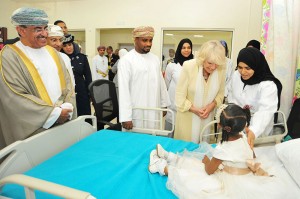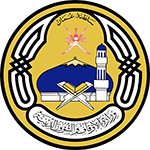Education & Health
 Towards achieving a well-rounded growth of the economy, Oman has been putting a lot of importance in promoting socio-economic development in the country. Expenditures against Education affairs and Health sector accounted for the largest shares of current expenditure under civil ministries, respectably for 32% and 12%.
Towards achieving a well-rounded growth of the economy, Oman has been putting a lot of importance in promoting socio-economic development in the country. Expenditures against Education affairs and Health sector accounted for the largest shares of current expenditure under civil ministries, respectably for 32% and 12%.
In the primary Education, official figures for the 2004/05 school year record around 600.000 students in 1022 government schools. 366 are for boys, 355 for girls and 301are mixed. There are a further 23.500 students in the Sultanate’s 129 private schools. Three schools are for special needs children, all come under the auspices of the government.
In 1994, the Ministry of Higher Education was established in order to implement educational and research plans and programmes offered by institutes of higher education under its supervision. In 1996 the private sector was invited to contribute to the higher education programme. Fourteen private colleges and four private universities are now operating in the Sultanate. In January 2003, the total number of staff working in the Educational Colleges was 1,051, including 94 Omanis (10%). Academic support staff numbered 213 of whom 205 were Omanis (96.2%). Meanwhile, administrative staff were 100% Omani.
In 1997, to diversify the provision of Higher Education and absorb the increasing number of secondary school graduates, the Law College was also created. A further consideration was the Sultanate’s demand for specialists in the field of Law necessitated by the re-organisation of the judiciary and the extension of its competencies, as well as ancillary posts in the Public Prosecutor’s Office, clerks of the courts, lawyers and the like. In 2004 the College’s intake was increased to 175 students, in line with the provisions of the sixth Five-Year Plan.
In 2000 the World Health organisation (WHO) placed the Sultanate 1st in the “Overall Level of Health Care” and 8th at World level for “Overall System Performance”. By the end of 2003 there were 49 hospitals with 4,501 beds, as well as 119 health centres and 10 polyclinics in Oman.
The Royal Hospital in Muscat is one of the Sultanate’s specialist referral hospitals/ In November 2004, an Oncology Centre where all types of cancer cases, including those needing radiotherapy oppened.
Before 1970 no more than 100 people were employed in the health sector and only 13 of those were doctors. However, by the end of 2003 the Ministry of Health had a staff of 18,579. Omanis accounted for 61% of the total workforce.
From 1998 to 2003, 459 Omanis have graduated from the Health Institutes which contributes to the Omanisation of the health sector.
Sultan Qaboos University
 Sultan Qaboos University was established in 1986 and, since its health service inception 17 years ago, has become known as a centre of academic excellence. It comprises seven colleges: Arts and Social Sciences, Commerce and Industry, Education, Science, Agricultural and Marine Sciences, Engineering, and Medicine and Health Sciences.
Sultan Qaboos University was established in 1986 and, since its health service inception 17 years ago, has become known as a centre of academic excellence. It comprises seven colleges: Arts and Social Sciences, Commerce and Industry, Education, Science, Agricultural and Marine Sciences, Engineering, and Medicine and Health Sciences.
While 557 students were admitted in the university’s inaugural year, the number admitted for the academic year 2003/4 on Bachelors, Masters and Diploma programmes totaled 3,105. The number of students graduating from these programmes in the academic year 2002/3 was 2,352 and the total number of students currently enrolled at the University for the academic year 2003/4 is 12,385. This increase in student numbers has been accompanied by a corresponding increase in the quality and professional competence of its graduates.
 Towards achieving a well-rounded growth of the economy, Oman has been putting a lot of importance in promoting socio-economic development in the country. Expenditures against Education affairs and Health sector accounted for the largest shares of current expenditure under civil ministries, respectably for 32% and 12%.
Towards achieving a well-rounded growth of the economy, Oman has been putting a lot of importance in promoting socio-economic development in the country. Expenditures against Education affairs and Health sector accounted for the largest shares of current expenditure under civil ministries, respectably for 32% and 12%.
In the primary Education, official figures for the 2004/05 school year record around 600.000 students in 1022 government schools. 366 are for boys, 355 for girls and 301are mixed. There are a further 23.500 students in the Sultanate’s 129 private schools. Three schools are for special needs children, all come under the auspices of the government.
In 1994, the Ministry of Higher Education was established in order to implement educational and research plans and programmes offered by institutes of higher education under its supervision. In 1996 the private sector was invited to contribute to the higher education programme. Fourteen private colleges and four private universities are now operating in the Sultanate. In January 2003, the total number of staff working in the Educational Colleges was 1,051, including 94 Omanis (10%). Academic support staff numbered 213 of whom 205 were Omanis (96.2%). Meanwhile, administrative staff were 100% Omani.
In 1997, to diversify the provision of Higher Education and absorb the increasing number of secondary school graduates, the Law College was also created. A further consideration was the Sultanate’s demand for specialists in the field of Law necessitated by the re-organisation of the judiciary and the extension of its competencies, as well as ancillary posts in the Public Prosecutor’s Office, clerks of the courts, lawyers and the like. In 2004 the College’s intake was increased to 175 students, in line with the provisions of the sixth Five-Year Plan.
In 2000 the World Health organisation (WHO) placed the Sultanate 1st in the “Overall Level of Health Care” and 8th at World level for “Overall System Performance”. By the end of 2003 there were 49 hospitals with 4,501 beds, as well as 119 health centres and 10 polyclinics in Oman.
The Royal Hospital in Muscat is one of the Sultanate’s specialist referral hospitals/ In November 2004, an Oncology Centre where all types of cancer cases, including those needing radiotherapy oppened.
Before 1970 no more than 100 people were employed in the health sector and only 13 of those were doctors. However, by the end of 2003 the Ministry of Health had a staff of 18,579. Omanis accounted for 61% of the total workforce.
From 1998 to 2003, 459 Omanis have graduated from the Health Institutes which contributes to the Omanisation of the health sector.
Sultan Qaboos University
 Sultan Qaboos University was established in 1986 and, since its health service inception 17 years ago, has become known as a centre of academic excellence. It comprises seven colleges: Arts and Social Sciences, Commerce and Industry, Education, Science, Agricultural and Marine Sciences, Engineering, and Medicine and Health Sciences.
Sultan Qaboos University was established in 1986 and, since its health service inception 17 years ago, has become known as a centre of academic excellence. It comprises seven colleges: Arts and Social Sciences, Commerce and Industry, Education, Science, Agricultural and Marine Sciences, Engineering, and Medicine and Health Sciences.
While 557 students were admitted in the university’s inaugural year, the number admitted for the academic year 2003/4 on Bachelors, Masters and Diploma programmes totaled 3,105. The number of students graduating from these programmes in the academic year 2002/3 was 2,352 and the total number of students currently enrolled at the University for the academic year 2003/4 is 12,385. This increase in student numbers has been accompanied by a corresponding increase in the quality and professional competence of its graduates.

